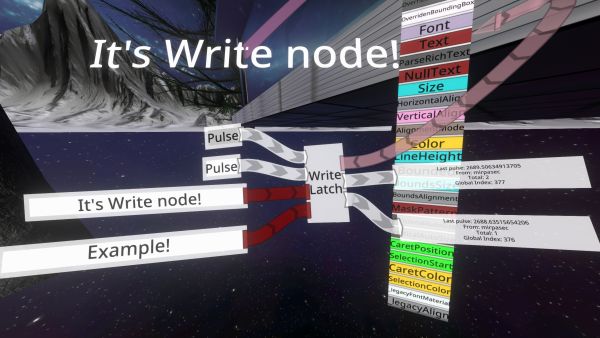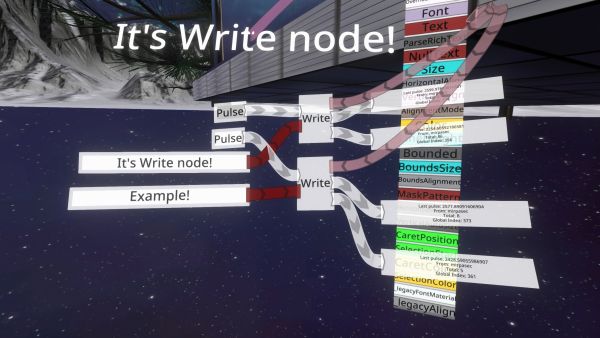Difference between revisions of "Write Latch (LogiX node)/ko"
(Updating to match new version of source page) |
|||
| Line 1: | Line 1: | ||
<languages></languages> | <languages></languages> | ||
| + | <div class="mw-translate-fuzzy"> | ||
'''Set'''에 '''Impulse'''가 입력되면 '''SetValue'''의 값을 출력의 Target에 보내고, '''OnSet'''에 '''Impulse'''를 바이패스합니다. '''Reset'''에 '''Impulse'''를 보내는 경우에는 '''ResetValue'''의 입력값을 '''Target'''에 보내고, '''OnReset'''에 '''Impulse'''를 바이패스하지요. | '''Set'''에 '''Impulse'''가 입력되면 '''SetValue'''의 값을 출력의 Target에 보내고, '''OnSet'''에 '''Impulse'''를 바이패스합니다. '''Reset'''에 '''Impulse'''를 보내는 경우에는 '''ResetValue'''의 입력값을 '''Target'''에 보내고, '''OnReset'''에 '''Impulse'''를 바이패스하지요. | ||
| + | </div> | ||
| + | <div class="mw-translate-fuzzy"> | ||
<!--[[File:|border|256px|right]]--> | <!--[[File:|border|256px|right]]--> | ||
| + | </div> | ||
| + | <div class="mw-translate-fuzzy"> | ||
== 입력인자 & 반환값 == | == 입력인자 & 반환값 == | ||
{| class="wikitable" | {| class="wikitable" | ||
| Line 28: | Line 33: | ||
| [[:Category:Types:Dummy|(dummy)]] | | [[:Category:Types:Dummy|(dummy)]] | ||
|} | |} | ||
| + | </div> | ||
| + | |||
| + | The <code>OnSet</code> output fires an impulse after an impulse is received at <code>Set</code>. This occurs regardless of whether there is a valid <code>Target</code> or whether any <code>Target</code> was actually written to. This continues the impulse chain which arrived at <code>Set</code>. | ||
| + | |||
| + | |||
| + | The <code>OnReset</code> output fires an impulse after an impulse is received at <code>Reset</code>. This occurs regardless of whether there is a valid <code>Target</code> or whether any <code>Target</code> was actually written to. This continues the impulse chain which arrived at <code>Reset</code>. | ||
| + | |||
| + | |||
| + | Changing the value of a Variable node, Component field etc. via a Write Latch node results in a datamodel change which will then be synchronised to other users in the session. Note that changes are only synchronised at the end of every update so, if multiple writes to the same target are performed by a single client within an update, only the final value will be sent. Additionally, no changes will be broadcast if the value is reset to the value it held at the beginning of an update. Due to this synchronisation process, it is inadvisable to write to a value very regularly (e.g. every update) unless absolutely necessary. It is generally better to use the [[drive|Drive]] system instead for continuously changing values to avoid unnecessary network traffic. [https://github.com/Neos-Metaverse/NeosPublic/issues/2590#issuecomment-874788205 Source]. | ||
| + | |||
| + | Generally, with a Write/Write Latch node, one can only write to component or slot fields which are value-typed (e.g. bools, ints, strings, floats), whereas reference-typed fields (e.g. slot, user, IAssetProvider<AudioClip> etc.) require [[Write Ref (LogiX node)|Write Ref]]. However, it ''is'' possible to write to reference-typed LogiX variable nodes using a Write/Write Latch node where it ''isn't'' possible to do so with Write Ref. It is also possible to write to reference-typed fields using Write/Write Latch if the input <code>SetValue</code> and <code>ResetValue</code> are RefIDs, rather than reference datatypes - it is generally not recommended to work with raw RefIDs though. | ||
| + | |||
| + | <div class="mw-translate-fuzzy"> | ||
{| class="wikitable" | {| class="wikitable" | ||
|+반환값 | |+반환값 | ||
| Line 48: | Line 66: | ||
| [[:LogiX:Impulses|Impulse]] | | [[:LogiX:Impulses|Impulse]] | ||
|} | |} | ||
| + | </div> | ||
| + | |||
| + | [[File:LogiX.Actions.WriteLatch.Example.jpg|600px|Example usage Write Latch]] | ||
| + | |||
| + | [[File:LogiX.Actions.Write.imp_WriteLatch.jpg|600px|Comparable usage of two Write nodes]] | ||
| + | <div class="mw-translate-fuzzy"> | ||
== 사용방법 == | == 사용방법 == | ||
이 노드의 입력인자인 '''SetValue'''와 '''ResetValue'''는 자료형이 확정되지 않은 '''Dummy'''로 표현됩니다. 노드에 연결하는 자료형에 맞추어 출력쪽 '''Target'''도 동일한 자료형을 사용할 수 있도록 작성하여 주세요. | 이 노드의 입력인자인 '''SetValue'''와 '''ResetValue'''는 자료형이 확정되지 않은 '''Dummy'''로 표현됩니다. 노드에 연결하는 자료형에 맞추어 출력쪽 '''Target'''도 동일한 자료형을 사용할 수 있도록 작성하여 주세요. | ||
| − | + | </div> | |
| − | |||
| − | |||
| − | |||
| − | |||
| − | |||
| − | |||
| − | |||
| − | |||
| − | |||
| − | |||
| − | |||
[[Category:LogiX{{#translation:}}|Write Latch]] | [[Category:LogiX{{#translation:}}|Write Latch]] | ||
| − | [[Category:LogiX: Actions{{#translation:}}|Write Latch]] | + | [[Category:LogiX:Actions{{#translation:}}|Write Latch]] |
| − | {{ | + | {{NodeMenu-Actions{{#translation:}}}} |
Revision as of 10:24, 3 January 2022
Set에 Impulse가 입력되면 SetValue의 값을 출력의 Target에 보내고, OnSet에 Impulse를 바이패스합니다. Reset에 Impulse를 보내는 경우에는 ResetValue의 입력값을 Target에 보내고, OnReset에 Impulse를 바이패스하지요.
입력인자 & 반환값
| 자료형 대표색 | 인자명 | 자료형 |
| Set | Impulse | |
| Reset | Impulse | |
| SetValue | (dummy) | |
| ResetValue | (dummy) |
The OnSet output fires an impulse after an impulse is received at Set. This occurs regardless of whether there is a valid Target or whether any Target was actually written to. This continues the impulse chain which arrived at Set.
The OnReset output fires an impulse after an impulse is received at Reset. This occurs regardless of whether there is a valid Target or whether any Target was actually written to. This continues the impulse chain which arrived at Reset.
Changing the value of a Variable node, Component field etc. via a Write Latch node results in a datamodel change which will then be synchronised to other users in the session. Note that changes are only synchronised at the end of every update so, if multiple writes to the same target are performed by a single client within an update, only the final value will be sent. Additionally, no changes will be broadcast if the value is reset to the value it held at the beginning of an update. Due to this synchronisation process, it is inadvisable to write to a value very regularly (e.g. every update) unless absolutely necessary. It is generally better to use the Drive system instead for continuously changing values to avoid unnecessary network traffic. Source.
Generally, with a Write/Write Latch node, one can only write to component or slot fields which are value-typed (e.g. bools, ints, strings, floats), whereas reference-typed fields (e.g. slot, user, IAssetProvider<AudioClip> etc.) require Write Ref. However, it is possible to write to reference-typed LogiX variable nodes using a Write/Write Latch node where it isn't possible to do so with Write Ref. It is also possible to write to reference-typed fields using Write/Write Latch if the input SetValue and ResetValue are RefIDs, rather than reference datatypes - it is generally not recommended to work with raw RefIDs though.
사용방법
이 노드의 입력인자인 SetValue와 ResetValue는 자료형이 확정되지 않은 Dummy로 표현됩니다. 노드에 연결하는 자료형에 맞추어 출력쪽 Target도 동일한 자료형을 사용할 수 있도록 작성하여 주세요.
| Actions | ||||||
|---|---|---|---|---|---|---|
| Back | -- | ++ | Drive | Drive Playback | Tween | Write |
| Write Latch | Write Ref | Write Ref Latch | ||||

